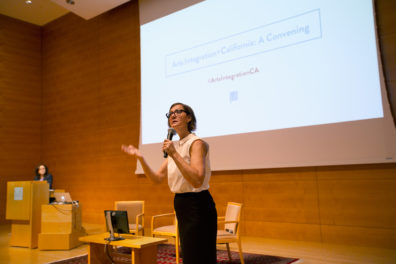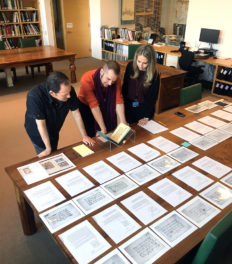
Nativity of Christ with the Adoration of the Shepherds and the Magi, 1615, Armenian. Tempera, gold, and ink on parchment, 9 1/16 x 6 5/16 in. The J. Paul Getty Museum, Ms. 118 (originally from Ms. Ludwig II 7). Digital image courtesy of Getty’s Open Content Program
This recently acquired leaf from a 17th-century Armenian manuscript shows the Christian story of the miraculous arrival of the Christ child on earth. In the early 20th century, the leaf was cut out of its original book, likely by an art dealer. However, we are now able to reunite it with the parent volume and a second detached leaf, which have been in Getty’s collection since 1983, and gain a renewed understanding of the manuscript as a whole.
Along with an Armenian manuscript from the 16th century, this leaf arrived to the Getty manuscript department last winter as part of the department’s continued efforts to extend the bounds of the collection beyond western Europe. Together, these two new acquisitions bring Getty’s Armenian manuscripts collection to seven. They allow us to tell richer stories in our exhibitions and to present a more complete history of Armenian illumination.
Tradition and Innovation in a New Gospel Book

Saint Matthew from a Gospel book, 1583, Armenian. Tempera colors and ink on parchment, 9 3/4 x 7 1/16 in. The J. Paul Getty Museum, Ms. 119, fol. 18v. Digital image courtesy of Getty’s Open Content Program
The 16th-century Armenian book is a Gospel book, containing the four Gospels of the Christian Bible. Gospel books were among the most precious and revered manuscripts in medieval Armenia because of their sacred nature and their use during church services.
This Gospel book opens with a cycle of twenty full-page illuminations showing scenes from Christian sacred history. Each of the four books of the Gospel begins with a portrait of an Evangelist, and, throughout the manuscript, numerous smaller decorative motifs highlight divisions in the text.
An inscription at the end of the volume, conventional in Armenian manuscripts, names the patron, Baron Mirza Jan, and the main artist and scribe, Ghoukas. It also says that the book was written in 1583 for a monastery in the borough of Karbi, which is in modern Armenia. A century later, another scribe added a note that names a later patron, Lord Martiros. It begs blessings for his family and for the priests of the monastery in Karbi, where the manuscript remained. Both the 16th- and the 17th-century inscriptions mourn the persecutions that Armenians were suffering under foreign rule.
This manuscript allows us to look more broadly at how Armenian illumination developed across time. It offers a visual link between the Getty’s two other Armenian Gospel books, one from the 14th century, and one from the 17th century. Both of these manuscripts have or formerly had a decorative cycle similar to that of the new manuscript.

The Baptism of Christ from a Gospel book, 1386, Armenian. Tempera and ink on parchment, 9 7/16 × 6 1/2 in. The J. Paul Getty Museum, Ms. Ludwig II 6, fol. 7. Digital image courtesy of Getty’s Open Content Program

The Baptism of Christ from a Gospel book, 1583, Armenian. Tempera and ink on parchment, 9 3/4 x 7 1/16 in. The J. Paul Getty Museum, Ms. 119, fol. 4. Digital image courtesy of Getty’s Open Content Program

The Baptism of Christ, 1615, Armenian. Tempera, gold, and ink on parchment, 9 × 6 3/4 in. The J. Paul Getty Museum, Ms. Ludwig II 7a. Digital image courtesy of Getty’s Open Content Program
Comparing the image of the baptism of Christ from each of the three manuscripts shows that the earliest manuscript is marked by fluid outlining, a limited use of color, and bare settings, while the later manuscript shows more convincing bodily forms, brilliant color contrasts, and extensive background patterning. The new Gospel book preserves much of the linearity of the earlier book, now expressed within frames and with the bolder vocabulary of color and pattern that characterizes the later book.

The Jesse Tree from a Gospel book, 1583, Armenian. Tempera and ink on parchment, 9 3/4 x 7 1/16 in. The J. Paul Getty Museum, Ms. 119, fol. 11v. Digital image courtesy of Getty’s Open Content Program

The Path 1583, Armenian. Tempera and ink on parchment, 9 3/4 x 7 1/16 in. The J. Paul Getty Museum, Ms. 119, fol. 6v. Digital image courtesy of Getty’s Open Content Program
The tradition of Armenian illumination centers around a series of standardized images related to the main themes of Christianity that are repeated regularly in Gospel books. This Gospel book is unusual in that it represents subjects that are rare within the greater corpus of Armenian illumination, including a full-page illustration of the Tree of Jesse (showing the ancestors of Christ), a relatively uncommon motif in Armenian art. Another scene shows souls climbing up a ladder to Christ or being consumed in hell. For this striking image, we have found only one comparable image in the entirety of the Armenian tradition, which, until now, has been described as unique. Neither of these scenes was previously represented in the collection.

Saint Matthew from a Gospel book, 1583, Armenian. Tempera colors and ink on parchment, 9 3/4 x 7 1/16 in. The J. Paul Getty Museum, Ms. 119, fol. 18v. Digital image courtesy of Getty’s Open Content Program

Saint Luke, about 1504–1505, Ethiopian. Tempera on parchment, 13 9/16 × 10 7/16 in. The J. Paul Getty Museum, Ms. 102, fol. 143v. Digital image courtesy of Getty’s Open Content Program

Saint Luke, late 13th century, Byzantium. Tempera and gold on parchment, 8 1/4 × 5 7/8 in. The J. Paul Getty Museum, Ms. 65, fol. 159v. Digital image courtesy of Getty’s Open Content Program
The portraits of the four Evangelists in the new manuscript recall ones in Ethiopian and Byzantine Gospel books, both of which are represented in Getty’s collections. Each of these traditions frequently included portraits of the four Evangelists writing their Gospels. In all of these images, the writer sits to the left, his thoughtful face tilted toward the reader. With his right hand, he begins to write the opening words of his gospel.

The Path 1583, Armenian. Tempera and ink on parchment, 9 3/4 x 7 1/16 in. The J. Paul Getty Museum, Ms. 119, fol. 6v. Digital image courtesy of Getty’s Open Content Program
Two of the new manuscript’s full-page illustrations seem to be by a different hand than the rest. These illustrations use a more restricted color palette, and, unlike the other images, contain areas that are outlined, but lack the decorative patterning pervasive in other scenes. They are painted on pages that are contemporaneous with the rest of the image cycle, perhaps by an associate or apprentice of the main artist and scribe, Ghoukas.
The manuscript also includes fascinating marginal notes added by the scribes, including “Remember Anprishat, he brought many meals to me,” and “The paper is not smoothed out well. Don’t blame me.” (translations by Jesse Siragan Arlen). We hope that highlighting details such as these will spark further research and understanding of the daily lives of craftspeople at the time.
Rediscovering a Page

Image: Nativity of Christ with the Adoration of the Shepherds and the Magi, 1615, Armenian. Tempera, gold, and ink on parchment, 9 1/16 x 6 5/16 in. The J. Paul Getty Museum, Ms. 118 (originally from Ms. Ludwig II 7). Digital image courtesy of Getty’s Open Content Program
The Getty’s second recent Armenian acquisition is a single, detached manuscript leaf with a large, brilliantly colored painting of the Nativity of Christ with the Adoration of the Shepherds and the Magi.
A trio of angels looks on from the upper right, as a ray of blue light shines from the heavens onto the Christ child, who is held by the reclining Virgin Mary. Joseph rests his hand on his face next to a shepherd, who plays a flute, while the ox and ass watch from above. At right, the three magi offer their gifts. The painting’s dynamic, geometric shapes and vibrant colors form a composition of great energy and vitality.

Saint John the Evangelist, 1615, Armenian. Tempera, gold, and ink on parchment, 9 1/16 × 6 3/4 in. The J. Paul Getty Museum, Ms. 118 (originally from Ms. Ludwig II 7) Digital image courtesy of Getty’s Open Content Program ).
The leaf was once part of a manuscript already in Getty’s collection, which was made in 1615 in Isfahan, Persia, and illustrated by the Armenian artist Mesrop of Khizan. When the Getty Museum acquired that Gospel book in 1983, a series of paintings grouped at the beginning of the manuscript had already been separated from the rest of the book for over 50 years. We do not know who cut out the pages, but dealers have been breaking up medieval books for centuries (a practice condemned today) to sell their parts separately for a greater price than the whole could fetch.

The Baptism of Christ, 1615, Armenian. Tempera, gold, and ink on parchment, 9 × 6 3/4 in. The J. Paul Getty Museum, Ms. Ludwig II 7a. Digital image courtesy of Getty’s Open Content Program
This new object is the second detached leaf that the Getty now owns from the opening cycle of the manuscript. In 1985, the manuscripts department acquired a leaf with an image of the Baptism. The painting uses the same bold colors, wavy, segmented patterns, and dynamic figures that characterize the new leaf. Three further leaves from the manuscript belong to the Chester Beatty library in Dublin, but the locations of the remaining leaves are unknown.
In studying and displaying the parts of the manuscript together, we hope to foster a better understanding of the manuscript’s original organization and imagery and of the vicissitudes of its long history.
In a note at the end of the above-described Gospel book, the artist Mesrop wrote, “God gave my feeble body strength to complete this book…” However, time can fragment and complicate even the most precious objects. These acquisitions allow us to reconstitute elements of cultural heritage and preserve them for future generations. They also challenge us to deepen and expand our understanding of Armenian manuscript illumination. We look forward to the study and excitement these two new members of the manuscripts collection will inspire.
Editor’s Note: This story was updated on March 18, 2021, to reflect a better understanding of the inscriptions at the end of the manuscript (colophons). We’ve removed references to Eghisabet as an artist in the manuscript. She has now been identified in the colophon as the sister of the manuscript’s patron (Baron Mirza Jan), not the sister of its artist. She did not play a role in the creation of the manuscript.




This is extraordinary. These manuscript illustrations have touched me this night the 22nd of December 2020. Thank You!!
Amazing find! Thank you Getty for your extraordinary effort in finding and preserving the great and rich ARMENIAN heritage and its abundance of cultural and artistic wealth for the world to know and for generations to come!
Magnificent collection and timely for the season. Well done! I’ve met several Armenians over the years who still grieve over the 20th century genocide which I believe was committed by the Turks although I could be mistaken. I love their reverential treatment of the Gospel accounts. Thanks.
One of the Magi (the one kneeling before the child) is missing a halo—distinction or omission?
Dear reader,
We had also noticed the missing halo, as well as the fact that only one of the Magi wears a crown. These are definitely areas for future research, one of the exciting prospects associated with acquisitions. Thanks for your comment.
Elizabeth Morrison
Senior Curator of Manuscripts
J. Paul Getty Museum